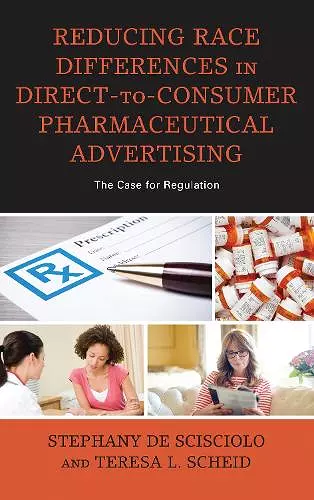Reducing Race Differences in Direct-to-Consumer Pharmaceutical Advertising
The Case for Regulation
Stephany De Scisciolo author Teresa L Scheid author
Format:Hardback
Publisher:Lexington Books
Published:15th Jul '18
Currently unavailable, and unfortunately no date known when it will be back

Reducing health disparities by increasing access to health information is a national health policy priority. Evidence exists that direct-to-consumer pharmaceutical advertising (DTCA) is effective in educating consumers about health issues. However, racial disparities exist in such advertising. In 2009, the Food and Drug Administration (FDA) issued a report that included recommendations for enhancing the ability of DTCA to reach disadvantaged populations, including racial and ethnic minorities. Reducing Race Differences in Direct to Consumer Pharmaceutical Advertising compares the pharmaceutical advertisements placed in five popular women’s magazines published prior to and following the 2009 FDA report to assess the impact of these recommendations on the content and appearance of advertisements placed in magazines of differing racial orientation. From a health policy perspective, the results are disappointing. The FDA recommendations had no impact on the frequency or content of the DTCA appearing in White-oriented versus Black-oriented magazines. In fact, far fewer drugs used to treat life-threatening conditions were advertised in Black-oriented magazines after the 2009 FDA recommendations. The book concludes that enhancing the educational and motivational value of DTCA will require more than a set of recommendations. The results shed light on the pharmaceutical industry’s compliance with both hard and soft regulation. Neither federal recommendations nor industry guidelines resulted in the changes to DTCA envisioned by the FDA. Regulatory action is necessary to ensure that pharmaceutical companies develop advertising campaigns that not only promote their products, but also positively impact the health outcomes of those who read their ads.
De Scisciolo and Scheid have asked a critical question related to the advertising of prescription pharmaceuticals to consumers—can such advertising improve health education and health outcomes while also reducing health disparities among ethnic or socioeconomic groups in the population? While effectively executed marketing communications might be able to accomplish the goals above, De Scisciolo and Scheid’s well designed research makes clear that when these organizations are left to their own devices, they do a poor job of delivering on the more lofty potential of direct-to-consumer advertising. They sell more drugs, but do little to improve health education and health outcomes, nor are health disparities improved, despite FDA and industry guidelines designed to facilitate such outcomes. The authors offer some excellent policy recommendations that would likely be far more effective. -- James L. Oakley, Lewis University
This volume is the go-to book for anyone wishing to find out the facts on direct to consumer magazine advertising of prescription drugs—whether you think the practice an outrageous and dangerous invasion of physicians’ prerogatives by evil pharmaceutical companies or long-needed consumer power to control health prices through competition. -- William P. Brandon, Emeritus Metrolina Medical Foundation Distinguished Professor of Health Policy, University of North Carolina Charlotte
ISBN: 9781498574167
Dimensions: 231mm x 159mm x 15mm
Weight: 404g
140 pages